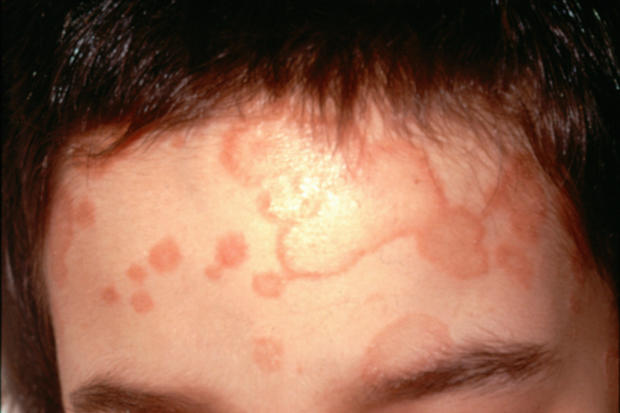A treatment-resistant, highly contagious form of the skin infection tinea, better known as ringworm, has been reported in the U.S. for the first time, the Centers for Disease Control and Prevention said Thursday. The cases were identified in two patients in New York City.
Ringworm is a common, superficial infection of the skin, hair or nails that is very contagious. It is caused by fungi and is typically treated with antifungal medications, but over the past decade, a treatment-resistant strain has emerged in South Asia. The CDC refers to that increase as “an epidemic.” Those cases are specifically referred to as Tinea indotineae infections.
These infections, the CDC said, are characterized by “widespread, inflamed, pruritic plaques,” or rashes with lesions. The rashes can appear on the body, the thigh, the crease of the thigh, the pubic region and the face. This version of the infection does not respond to terbinafine, the front-line medication used to treat most tinea cases.
Treatment-resistant cases have been diagnosed in Asia, Europe and Canada, but the New York City cases mark the first time they have been diagnosed in the United States.
The New York City cases were reported to federal health officials by a dermatologist on Feb. 28, 2023, who said two patients with severe tinea had symptoms that did not improve with standard treatments, raising alarm.
The patients, both women, shared no links to each other, the CDC said. The first woman, identified as Patient A, was 28 at the time and developed a widespread rash in the summer of 2021. She had no international travel history. In January 2022, after giving birth to a baby, she was diagnosed with tinea and began oral treatment, which did not relieve her symptoms. After a second course of treatment, using the medication itraconazole, her rash was resolved after four weeks, but she is still being monitored for recurrence.
BSIP/UIG Via Getty Images
The second patient, identified as Patient B in the CDC report, was 47 when she developed a widespread rash in the summer of 2022. She was traveling in Bangladesh at the time, where she was treated with topical creams. Several family members developed similar symptoms, she said. When she returned to the United States, she went to an urgent care center and was prescribed another topical treatment, with no improvement. In December 2022, she took a four-week course of oral medications, which also had no effect. A second four-week course of another medication led to “approximately 80% improvement.”
The woman’s son and husband live in the same house and have reported similar symptoms. They are being evaluated for possible treatments, the CDC said.
Skin samples taken from the two women first identified the infection as Trichophyton mentagrophytes, another form of ringworm. Further analysis and sequencing correctly identified the infection as Tinea indotineae.
The CDC said the infections show that health care providers should consider Tinea indotineae as a diagnosis when first-line medications and antifungal agents do not relieve symptoms. Any provider who suspects this infection should contact public health officials.
People who suspect they may have this infection should see their doctor or a dermatologist.
Tinea of all forms spreads easily through skin-to-skin contact with an infected person or animal. There can also be secondary spread among different parts of the body.

 Latest Breaking News Online News Portal
Latest Breaking News Online News Portal






